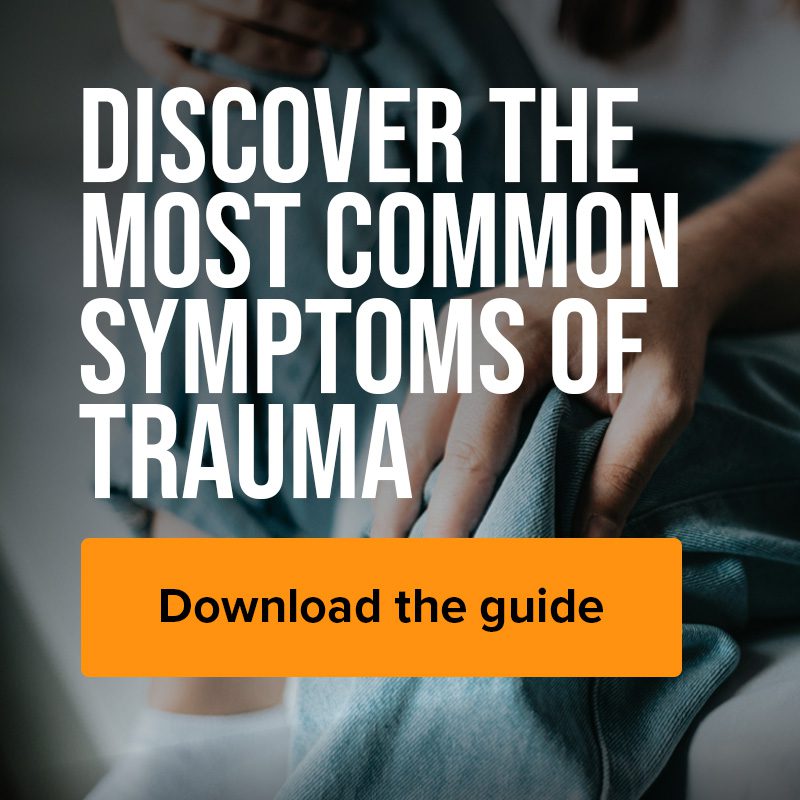Trauma and Post-Traumatic Stress Disorder
Traumatic events happen all around us, so it should come as no surprise that almost everyone in the world will be exposed to trauma at some point in their lives. In fact, 90% of US adults and 76% of Canadian adults report exposure to at least one traumatic event.1,2
Traumatic events include but are not limited to:
– Physical or sexual assault
– Witnessing a death or serious violent event
– Witnessing or experiencing a major accident or fire
– Exposure to war or combat
Although many people experience it, everyone deals with and responds to trauma differently. Some have minimal long-term effects, while others may develop a trauma- and stressor-related disorder, such as post-traumatic stress disorder (PTSD) or acute stress disorder (ASD). Whether or not a person develops these conditions typically depends on the type, number, and intensity of traumatic events, as well as sex, age, social factors, and their specific circumstances at the time.3
But what exactly are trauma- and stressor-related disorders?
Both post-traumatic stress disorder and acute distress disorder are conditions that occur as a direct result of experiencing, witnessing, or learning about one or more traumatic event.
Symptoms of PTSD and ASD include:4,5
– Recurrent memories, dreams, or flashbacks of a traumatic event
– Intense psychological and/or physical distress
– Avoidance of trauma-associated cues or stimuli
– Negative alterations to mood or cognitive ability
– Irritable, angry, or reckless behaviour
– Disturbed sleep (e.g. due to heightened alertness)
– Derealization (a distorted sense of reality)
– Depersonalization (feeling detached from the body or mind)
In order to be diagnosed with post-traumatic stress disorder or acute distress disorder, your symptoms need to a) significantly disturb your personal life, social life, or career and b) not be caused by a substance (e.g. a medication or alcohol) or illness.6
The key difference between PTSD and ASD is in how long it takes to experience symptoms, and how long these symptoms last, following a traumatic event. PTSD is diagnosed when you’ve been experiencing symptoms for at least a month, whereas ASD can be diagnosed as soon as 3 days post-traumatic event.7,8 Patients with ASD may also report more dissociative symptoms, like out-of-body experiences and an altered sense of reality.
Another thing to note is that post-traumatic stress disorder often occurs alongside other mental health disorders. For example, 1 in 2 people who have been diagnosed with PTSD also suffer from a mood, anxiety, or substance-use disorder.9 It’s also fairly common for individuals with PTSD to exhibit suicidal behaviour.10
Some consider ASD to be a natural pre-cursor to chronic PTSD. However, this is not always the case. In other words, not all individuals with ASD go on to develop PTSD, and not all PTSD patients were previously diagnosed with ASD.
A better way of looking at it is that there are 4 common trajectories that humans will demonstrate in their response to trauma:11
1. “Resiliency” – fairly minor PTSD symptoms that don’t progress
2. “Recovery” – more severe PTSD symptoms that improve over time
3. “Delayed reaction” – minimal PTSD symptoms that worsen over time
4. “Chronic distress” – more severe PTSD symptoms that don’t improve
No matter your trauma trajectory, research shows that accessing psychotherapy soon after a traumatic event can help lower your risk of PTSD, or improve PTSD or ASD symptoms if you’re already experiencing them.12,13
TREATMENTS FOR TRAUMA AND POST-TRAUMATIC STRESS DISORDER
It’s extremely important to treat the negative effects of trauma, and trauma- and stressor-related disorders like PTSD and ASD, because of the profound impact they have one’s quality of life. So, how can you determine the best way to treat your trauma?
Trauma treatment is either pharmacological (i.e. by taking medication), psychological (involving talking therapy), or a combination of both.
Pharmacological therapy aims to treat both direct and indirect PTSD symptoms, as patients with PTSD often suffer from concurrent mental health disorders. However, there is limited scientific evidence to support the effectiveness of drug therapy for PTSD, so this approach may not be the best option for everyone.14
Medications that are commonly prescribed for PTSD include:15
– Anti-depressants (e.g. sertraline, paroxetine, fluoxetine, or venlafaxine)
– Anti-anxiety drugs
– Anti-psychotics
In contrast, psychological therapy (also known as “talk therapy”) has a strong, proven track record among trauma patients. If you’ve experienced trauma and require support, some psychotherapy treatment options you may wish to explore include:16
– Cognitive behavioral therapy (helps you recognize and change negative thoughts and behaviours surrounding your trauma)
– Prolonged exposure therapy (exposes you to your trauma in a safe environment, through writing or visualization, to help reduce negative responses towards it)
– Cognitive therapy (helps you modify negative memories of the trauma that have been affecting your everyday life)
– Cognitive processing therapy (helps you challenge your negative, damaging beliefs about your trauma)
Let’s dive a little deeper into cognitive processing therapy, as it’s one of the most effective trauma treatments and is typically chosen as a first-line therapy.17,18
What is Cognitive Processing Therapy
As mentioned, cognitive processing therapy (CPT) supports you in reassessing or altering the beliefs surrounding your trauma that negatively impact your mental health. CPT involves multiple therapy sessions that aim to help you a) challenge your thoughts and emotions towards your trauma and b) develop skills and adaptive strategies to re-frame these thoughts and emotions positively.
Cognitive processing therapy sessions are centered around the following core themes:19
– Safety
– Trust
– Power
– Control
– Self-esteem
– Intimacy
– Facing the future
If you’re feeling overwhelmed at the prospect of starting cognitive processing therapy, don’t worry! Its process is designed to naturally ease you in. To help you set yourself realistic expectations when entering into a CPT relationship, let’s explore what this form of therapy might involve.
Your first counselling session will give you more background information about CPT and how it works. Your counsellor will also want to discuss the nature of your trauma, explain the connection between your thoughts and emotions, and describe how ‘automatic thoughts’ can contribute to your PTSD symptoms. Finally, you may be asked to write about how your trauma has affected you and how you’ve adapted to dealing with your traumatic experience(s).20,21
Out-of-session, reflective work, to help you get the most out of your cognitive processing therapy sessions, can be quite extensive. As you begin to re-interpret and re-frame your trauma, these take-home assignments and worksheets will help you organize and make sense of your thoughts and feelings.22,23
Subsequent counselling sessions will hone in on any trauma-related dysfunctional thinking patterns you may have, challenging these thoughts and ideas, and helping you further develop alternative thought patterns. This process of proactively challenging your beliefs is a skillset that you’ll learn and develop throughout your program. The end goal of CPT is that you’ll have a better quality of life through being able to apply these practical skills wherever needed, which will be evident when you compare your “before and after” written homework statements.24
In a review of 114 randomized, controlled trials, cognitive processing therapy came out on top as the trauma therapy with the strongest clinical effect, along with cognitive therapy and prolonged exposure therapy.25 CPT is effective in both children and adults for multiple types of trauma, including sexual abuse and military traumas.26 CPT is also a proven approach to reducing attachment-related avoidance in abused adolescents and young adults, as well as in patients with acute stress disorder.27,28
Choosing a Cognitive Processing Therapy Approach
As you can see, cognitive processing therapy can be quite an intensive process, involving multiple lengthy sessions and extensive at-home work. Because of this, it’s possible to undergo CPT as either an outpatient or an inpatient. Both program types have demonstrated beneficial outcomes for patients. So, if you feel CPT is worth pursuing, how should you decide which option may be best for you?
One of the benefits to choosing an inpatient treatment program is that it can help keep you focused when undergoing the above-mentioned processes, and this could optimize how you receive and respond to care. Inpatient cognitive processing therapy has been demonstrated to reduce PTSD symptoms, including suicidality, by reducing patients’ perceived burden on others and restructuring their negative beliefs.29
For example, veterans with PTSD who receive CPT in residential rehabilitation programs report greater symptom improvement compared to those receiving treatment outside of residency.30 Studies also show that the longer people with PTSD receive inpatient treatment, the more improvement they see in their symptoms and the less they need to use outpatient services.31
Despite such encouraging scientific evidence and all of the clinical success stories supporting cognitive processing therapy for trauma, you likely won’t see results right away – it may take some time before you experience symptom improvement. CPT sessions typically run over a period of 12 weeks, so the benefits of CPT are not expected to be evident from Day 1. Long-term commitment and program dedication is necessary, and any symptom improvement that you experience will be gradual.
That said, one of the best things about taking a cognitive processing therapy approach to managing trauma is that the results are long-lasting. Several scientific studies have proven that PTSD symptom improvement can last for many months, or even years, after CPT program completion.32 It’s, therefore, no wonder that the American Psychological Association (APA) Guideline Development Panel for the Treatment of PTSD strongly recommends CPT, among other cognitive behavioral therapies, as a first-line treatment option for adult patients with PTSD.33
Of course, every patient is different in how they respond to trauma therapy, and certain treatments may work better for some than others. However, the benefits of CPT to treat trauma- and stressor-related disorders have been repeatedly demonstrated such that CPT is often recommended as the gold standard of all cognitive behavioral therapy approaches.
Although it can seem daunting to make your first move in seeking out treatment, and to continue receiving treatment if you’re not seeing immediate results, knowing when to ask for help is critical. If your trauma is negatively affecting your quality of life, wellbeing, or relationships, taking that first step can be instrumental in developing long-term strategies to manage your beliefs about your trauma and getting your life back on track.
References:
1. Kilpatrick DG, Resnick HS, Milanak ME, Miller MW, Keyes KM, Friedman MJ. National estimates of exposure to traumatic events and PTSD prevalence using DSM-IV and DSM-5 criteria. J Trauma Stress. 2013 Oct;26(5):537-47. doi: 10.1002/jts.21848.
2. Van Ameringen M, Mancini C, Patterson B, Boyle MH. Post-traumatic stress disorder in Canada. CNS Neurosci Ther. 2008 Fall;14(3):171-81. doi: 10.1111/j.1755-5949.2008.00049.x.
3. Shalev A, Liberzon I, Marmar C. Post-Traumatic Stress Disorder. N Engl J Med. 2017 Jun 22;376(25):2459-2469. doi: 10.1056/NEJMra1612499.
4. Shalev A, Liberzon I, Marmar C. Post-Traumatic Stress Disorder. N Engl J Med. 2017 Jun 22;376(25):2459-2469. doi: 10.1056/NEJMra1612499.
5. Bryant RA. The Current Evidence for Acute Stress Disorder. Curr Psychiatry Rep. 2018 Oct 13;20(12):111. doi: 10.1007/s11920-018-0976-x.
6. Shalev A, Liberzon I, Marmar C. Post-Traumatic Stress Disorder. N Engl J Med. 2017 Jun 22;376(25):2459-2469. doi: 10.1056/NEJMra1612499.
7. Shalev A, Liberzon I, Marmar C. Post-Traumatic Stress Disorder. N Engl J Med. 2017 Jun 22;376(25):2459-2469. doi: 10.1056/NEJMra1612499.
8. Bryant RA. The Current Evidence for Acute Stress Disorder. Curr Psychiatry Rep. 2018 Oct 13;20(12):111. doi: 10.1007/s11920-018-0976-x.
9. Shalev A, Liberzon I, Marmar C. Post-Traumatic Stress Disorder. N Engl J Med. 2017 Jun 22;376(25):2459-2469. doi: 10.1056/NEJMra1612499.
10. Shalev A, Liberzon I, Marmar C. Post-Traumatic Stress Disorder. N Engl J Med. 2017 Jun 22;376(25):2459-2469. doi: 10.1056/NEJMra1612499.
11. Bryant RA. The Current Evidence for Acute Stress Disorder. Curr Psychiatry Rep. 2018 Oct 13;20(12):111. doi: 10.1007/s11920-018-0976-x.
12. Shalev A, Liberzon I, Marmar C. Post-Traumatic Stress Disorder. N Engl J Med. 2017 Jun 22;376(25):2459-2469. doi: 10.1056/NEJMra1612499.
13. Bryant RA. The Current Evidence for Acute Stress Disorder. Curr Psychiatry Rep. 2018 Oct 13;20(12):111. doi: 10.1007/s11920-018-0976-x.
14. Shalev A, Liberzon I, Marmar C. Post-Traumatic Stress Disorder. N Engl J Med. 2017 Jun 22;376(25):2459-2469. doi: 10.1056/NEJMra1612499.
15. Shalev A, Liberzon I, Marmar C. Post-Traumatic Stress Disorder. N Engl J Med. 2017 Jun 22;376(25):2459-2469. doi: 10.1056/NEJMra1612499.
16. American Psychological Association. PTSD treatment. Retrieved April 22, 2021 from https://www.apa.org/ptsd-guideline/treatments
17. Lewis C, Roberts NP, Andrew M, Starling E, Bisson JI. Psychological therapies for post-traumatic stress disorder in adults: systematic review and meta-analysis. Eur J Psychotraumatol. 2020 Mar 10;11(1):1729633. doi: 10.1080/20008198.2020.1729633. eCollection 2020.
18. Guideline Development Panel for the Treatment of PTSD in Adults, American Psychological Association. Summary of the clinical practice guideline for the treatment of posttraumatic stress disorder (PTSD) in adults. Am Psychol. 2019 Jul-Aug;74(5):596-607. doi: 10.1037/amp0000473.
19. American Psychological Association. Cognitive Processing Therapy (CPT). Retrieved April 22, 2021 from https://www.apa.org/ptsd-guideline/treatments/cognitive-processing-therapy
20. American Psychological Association. Cognitive Processing Therapy (CPT). Retrieved April 22, 2021 from https://www.apa.org/ptsd-guideline/treatments/cognitive-processing-therapy
21. Nixon RD. Cognitive processing therapy versus supportive counseling for acute stress disorder following assault: a randomized pilot trial. Behav Ther. 2012 Dec;43(4):825-36. doi: 10.1016/j.beth.2012.05.001. Epub 2012 May 11.
22. Monson CM, Resick PA, Rizvi SL. Posttraumatic stress disorder CPT Case Example. In D.H. Barlow (Ed.), Clinical handbook of psychological disorders (5th ed., pp. 80-113). New York, NY: Guilford Press.
23. Nixon RD. Cognitive processing therapy versus supportive counseling for acute stress disorder following assault: a randomized pilot trial. Behav Ther. 2012 Dec;43(4):825-36. doi: 10.1016/j.beth.2012.05.001. Epub 2012 May 11.
24. Monson CM, Resick PA, Rizvi SL. Posttraumatic stress disorder CPT Case Example. In D.H. Barlow (Ed.), Clinical handbook of psychological disorders (5th ed., pp. 80-113). New York, NY: Guilford Press.
25. Lewis C, Roberts NP, Andrew M, Starling E, Bisson JI. Psychological therapies for post-traumatic stress disorder in adults: systematic review and meta-analysis. Eur J Psychotraumatol. 2020 Mar 10;11(1):1729633. doi: 10.1080/20008198.2020.1729633. eCollection 2020.
26. Lewis C, Roberts NP, Andrew M, Starling E, Bisson JI. Psychological therapies for post-traumatic stress disorder in adults: systematic review and meta-analysis. Eur J Psychotraumatol. 2020 Mar 10;11(1):1729633. doi: 10.1080/20008198.2020.1729633. eCollection 2020.
27. Rimane E, Steil R, Renneberg B, Rosner R. Get secure soon: attachment in abused adolescents and young adults before and after trauma-focused cognitive processing therapy. Eur Child Adolesc Psychiatry. 2020 Sep 12. doi: 10.1007/s00787-020-01637-x. Online ahead of print.
28. Nixon RD. Cognitive processing therapy versus supportive counseling for acute stress disorder following assault: a randomized pilot trial. Behav Ther. 2012 Dec;43(4):825-36. doi: 10.1016/j.beth.2012.05.001. Epub 2012 May 11.
29. Blain RC, Pukay-Martin ND, Martin CE, Dutton-Cox CE, Chard KM. Residential Cognitive Processing Therapy Decreases Suicidality by Reducing Perceived Burdensomeness in Veterans with Posttraumatic Stress Disorder. J Trauma Stress. 2020 Oct 31. doi: 10.1002/jts.22618. Online ahead of print.
30. Alvarez J, McLean C, Harris AH, Rosen CS, Ruzek JI, Kimerling R. The comparative effectiveness of cognitive processing therapy for male veterans treated in a VHA posttraumatic stress disorder residential rehabilitation program. J Consult Clin Psychol. 2011 Oct;79(5):590-9. doi: 10.1037/a0024466.
31. Banducci AN, Bonn-Miller MO, Timko C, Rosen CS. Associations between residential treatment length, PTSD, and outpatient healthcare utilization among veterans. Psychol Serv. 2018 Nov;15(4):529-535. doi: 10.1037/ser0000204. Epub 2017 Dec 21.
32. Shalev A, Liberzon I, Marmar C. Post-Traumatic Stress Disorder. N Engl J Med. 2017 Jun 22;376(25):2459-2469. doi: 10.1056/NEJMra1612499.
33. Guideline Development Panel for the Treatment of PTSD in Adults, American Psychological Association. Summary of the clinical practice guideline for the treatment of posttraumatic stress disorder (PTSD) in adults. Am Psychol. 2019 Jul-Aug;74(5):596-607. doi: 10.1037/amp0000473.




